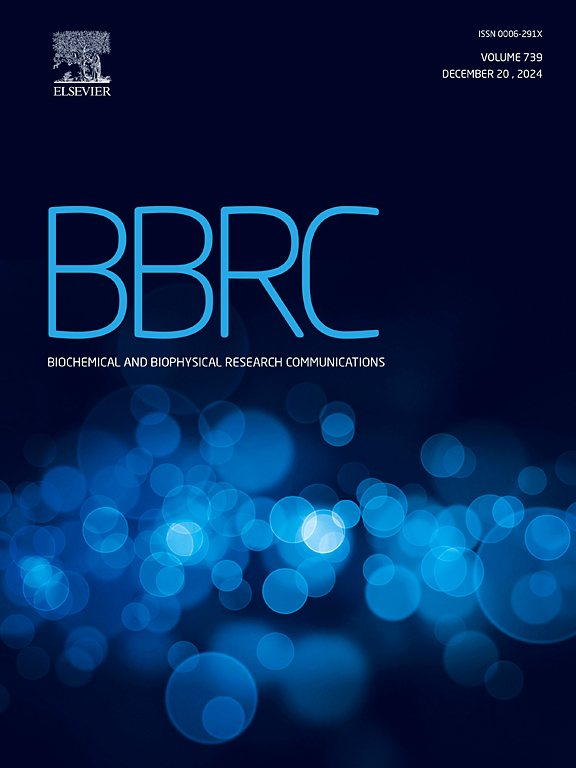Formononetin prevents intestinal injury caused by radiotherapy in colorectal cancer mice via the Keap1-Nrf2 signaling pathway
IF 2.5
3区 生物学
Q3 BIOCHEMISTRY & MOLECULAR BIOLOGY
Biochemical and biophysical research communications
Pub Date : 2025-03-20
DOI:10.1016/j.bbrc.2025.151676
引用次数: 0
Abstract
Radiation-induced intestinal injury (RIII) is a serious complication of radiation therapy. Formononetin (FT) is a methoxy isoflavone with anti-tumor and anti-oxidant properties. This study explored whether FT reduces ROS by activating the Keap1/Nrf2 pathway and thereby protecting against RIII. 30 BABL/C mice were used to construct a colorectal cancer model with CT26 cells and validated the model on day 7. Then, the cancer model mice were divided into 3 groups on day 14 (model control, model, and model + FT) with administration of FT or saline and radiated them on day 21. All samples were collected on day 28. Mechanical intestinal barrier assessed via intestinal absorption function, HE staining, and Claudin-1, Occludin, ZO-1 expression. Apoptosis was measured by TUNEL and cleaved-caspase 3, angiogenesis by CD31, and oxidative stress by NO and ROS levels. Keap1, Nrf2 (cytoplasm) and Nrf2 (nucleus) expression were measured by Western blot. FT treatment enhanced absorption and reduced damage and apoptosis in intestinal tissue. During FT treatment, inhibition of NO and ROS leads to suppression of oxidative stress and promotion of CD31 expression promotes angiogenesis. FT upregulated the expression of nuclear Nrf2 and reduced cytoplasmic Keap1 and Nrf2. FT strengthens mechanical barrier and decreases oxidative stress in intestinal tissue, providing radiation injury protection. Its anti-radiation effect may be through Keap1/Nrf2 pathway activation.
放射性诱导的肠道损伤(RIII)是放射治疗的一种严重并发症。福莫西汀(FT)是一种具有抗肿瘤和抗氧化特性的甲氧基异黄酮。本研究探讨了 FT 是否能通过激活 Keap1/Nrf2 途径来减少 ROS,从而防止 RIII 的发生。用 30 只 BABL/C 小鼠与 CT26 细胞构建结直肠癌模型,并在第 7 天对该模型进行验证。然后,在第 14 天将癌症模型小鼠分为 3 组(模型对照组、模型组和模型 + FT 组),分别给予 FT 或生理盐水,并在第 21 天对其进行放射治疗。第 28 天收集所有样本。通过肠道吸收功能、HE 染色和 Claudin-1、Occludin、ZO-1 表达评估机械性肠屏障。通过TUNEL和裂解-天冬酶3检测细胞凋亡,通过CD31检测血管生成,通过NO和ROS水平检测氧化应激。Keap1、Nrf2(细胞质)和 Nrf2(细胞核)的表达通过 Western 印迹进行检测。FT 治疗促进了肠道组织的吸收,并减少了肠道组织的损伤和凋亡。在 FT 治疗期间,抑制 NO 和 ROS 可抑制氧化应激,促进 CD31 的表达,从而促进血管生成。FT 上调了核 Nrf2 的表达,减少了细胞质 Keap1 和 Nrf2 的表达。FT 可增强肠道组织的机械屏障,降低氧化应激,提供辐射损伤保护。它的抗辐射作用可能是通过激活 Keap1/Nrf2 通路实现的。
本文章由计算机程序翻译,如有差异,请以英文原文为准。
求助全文
约1分钟内获得全文
求助全文
来源期刊
CiteScore
6.10
自引率
0.00%
发文量
1400
审稿时长
14 days
期刊介绍:
Biochemical and Biophysical Research Communications is the premier international journal devoted to the very rapid dissemination of timely and significant experimental results in diverse fields of biological research. The development of the "Breakthroughs and Views" section brings the minireview format to the journal, and issues often contain collections of special interest manuscripts. BBRC is published weekly (52 issues/year).Research Areas now include: Biochemistry; biophysics; cell biology; developmental biology; immunology
; molecular biology; neurobiology; plant biology and proteomics

 求助内容:
求助内容: 应助结果提醒方式:
应助结果提醒方式:


